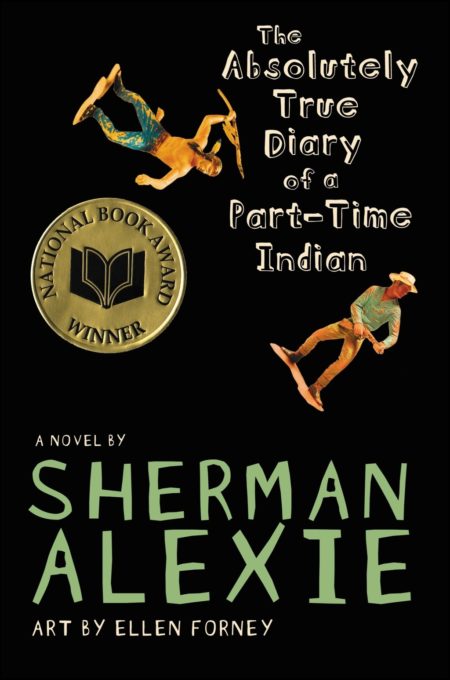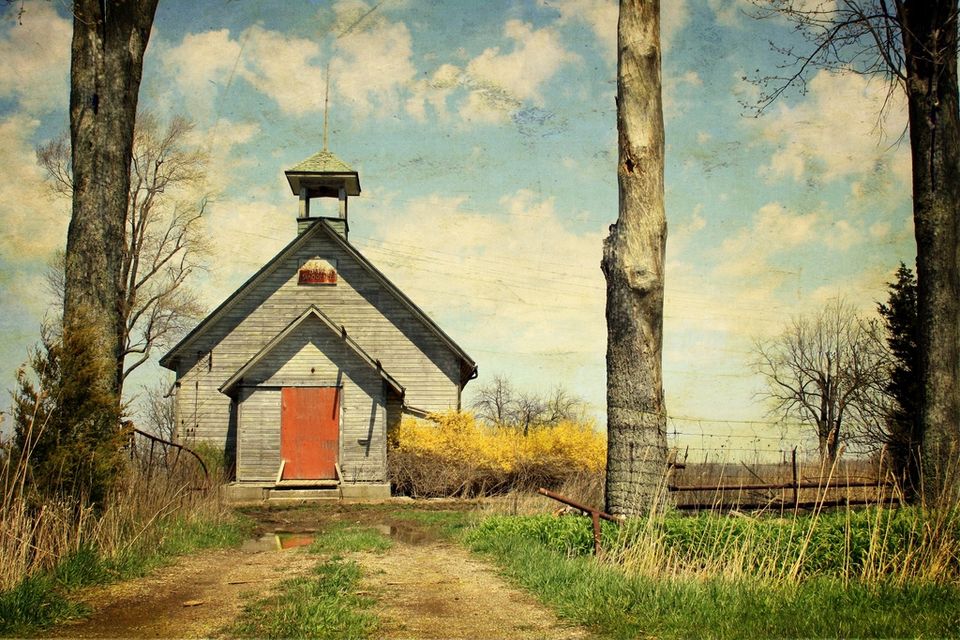A couple years ago we painted a map of the country on the wall by the guidance office. There’s really nothing strange about this (what’s weird about a map on the wall of a high school?), and as I walk by it, heading from the English department toward the activities office, I frequently pause to examine the small papers posted where students plan to attend school next. Mostly, the papers cluster around South Dakota’s state schools, and a few dapple Minnesota, where we enjoy reciprocity.
It reminds me of the wall in my own high school in New Hampshire, where the guidance office hung laminated pennants decorated with our photos and post-high destinations. My friends were headed to places like New York, New Jersey, Pennsylvania, Washington DC, Rhode Island, Massachusetts, and Oklahoma, while I was headed to Illinois.
Illinois is a long way from New Hampshire and before I visited my college, the furthest west I’d traveled was Florida. Upon attending, I was completely on my own, and I loved it. What was most important was that it was my college. I had discovered in this place, even in its brochures, an expression of myself, a setting befitting the person I wanted to be, even if I was aware that every college in existence was promising I could be a good-looking and intelligent pedestrian among orange deciduous trees.
It happened just like I’d hoped it would, too. My new environment encouraged me to thrive in particular ways, and I sensed the change when I returned home on breaks. I didn’t hang out with my high school friends much, though I harbored no animosity towards them. Yes, I was back, but I had replaced the ties of my old life with ties that matched my desires, a set of customized bonds. I’d inserted myself into a different community, one that kindled what I saw as my truer self.
These are the contours of my story, but the story’s arc is common enough to be a cliché. The teenager goes off in search of self-actualization and chooses a school that fits his vision of what he’d like to be. Colleges play their role by offering a particular “cultural identity” (Prescott College) and promising a corresponding experience of “personal transformation” (New England College) that will leave the student “caring about the community” and a “citizen of the world” (Whitman College). And as a cog in the machine meant to churn out cosmopolitan college graduates, I help cast my students as characters in this story: find out who you are, pick the perfect college for you, pursue your dream.
Yet as my high school economics teacher taught me, there is such a thing as an opportunity cost. To pursue one experience is to forgo another. As teenagers pursue their customized experiences of self-fulfillment, what are they missing? What are they giving up?
One thing they’re giving up is their high school classmates. When I watch my seniors hug goodbye to one another, trying not to poke each other in the eye with their silly square hats, it occurs to me how permanent some of those goodbyes will prove to be. I uttered the same goodbyes twenty years ago to people I have not seen since, and while I don’t regret leaving, I must admit that this separation from my community is one of the heavy costs of pursuing my own path. To customize my life meant to unknit myself from previous communal experience.
I recognize these contours in stories far different than my own, even in Sherman Alexie’s novel The Absolutely True Diary of a Part-Time Indian, where Arnold Spirit, an intellectually curious young man, decides to attend school off his reservation. Arnold needs to leave to keep from despairing, and as his teacher asserts, “You’re going to find more and more hope the farther and farther you walk from this sad, sad, sad reservation.”

So Arnold goes, and the greatest cost is his bond with his best friend, Rowdy, a cost Arnold realizes most powerfully when the two play against each other in a basketball game. Rowdy, a natural athlete, has always destroyed Arnold in their pickup games, but in this instance Arnold plays better than he ever thought possible, and his team beats Rowdy’s. Though he’s the hero, Arnold realizes after the final buzzer that while he had seen himself as the underdog, it’s his old school who is David, and he’s joined Goliath. With this thought, he recognizes his adoption of this new community as a kind of betrayal. He throws up and weeps, “because I had broken my best friend’s heart.”
Being a novel, Alexie moves Arnold to a place of insight. He weeps at the end because he wants his old community to have hope like his, but “I was the only one who was brave and crazy enough to leave the rez. I was the only one with enough arrogance.” And while Arnold won’t be going back, he wants to find Rowdy “and hug him and beg him to forgive me for leaving.” He thus lands where he can see the good of his leaving, even as he recognizes the importance of loving those he’d left.
Like I mentioned, Arnold’s ordeal is mostly foreign to me. I didn’t need to leave my hometown and my leaving was not viewed as cultural betrayal; but I still understand his impulse to ask forgiveness.
Mine was the ultimate knitted community, a town of fewer than 5,000 residents where the entire eighth grade class traveled to Washington DC on one bus. We attended a regional high school, which swelled our class’s ranks to 100, but that did not destroy our links, it simply extended the chain. We all knew what it was to jump off the covered bridge, to ski the Twister trail at Pat’s Peak, to get speeding tickets on Route 114. We knew who owned the town’s old names, which classmates were cousins, and whose dog would never bite if you entered the house when no one was home. These were experiences that were shared, not customized.
And while these were all good things—privileged things, really—to customize our experiences, we left. We withdrew ourselves from the limitations of what our small town could offer. We left behind the accents of the lifetime New Hampsha’ men for the spoils of a particular college. You can’t have it all, so we gave up our small-town community.
I see via Facebook that a few of us have returned, but I don’t know how many because I’m not there. A single plane ticket to New England costs around $600. A drive takes thirty hours. I won’t attend my high school reunion and, a bit like Arnold Spirit, feel a compulsion to apologize to my childhood friends.
In light of this, I recognize that when my students cry at graduation, they’re emotional for legitimate reasons, especially the students pursuing their dreams in California or Arizona. They’re right to see their leaving for college, in part, as a loss. I doubt they’ll change their minds or regret their decision, but to recognize the loss is at least to concede a certain reality.
It’s a reality we educators frequently deny. Each year when my students register for classes, my colleagues and I emphasize what their priorities should be: sign up for what you need, for classes you’re interested in and classes that will help you pursue your goals. Don’t just sign up for the classes your friends are taking. Then we extend the same advice to college: Don’t just pick the school your boyfriend is going to. Don’t be roommates with your friends.
In many specific cases that’s good advice, but I admittedly dole out the idea as a self-evident maxim. I wonder if I’ve been as right as I’ve thought. When students choose to value community over customization, who am I to say they’re wrong? I’ll always praise the man who elects to spend time with his children rather than pursue a promotion; why am I so loathe to praise the student who adheres to the same priorities in choosing classes or a college?
Even though I’ll never regret my choice regarding college, I could benefit from a mindset that values community more and a customized experience less. The conflict between the two recalls a passage from The Screwtape Letters, C.S. Lewis’s fictional collection of letters from the demon Screwtape to his nephew, Wormwood. At one point, Screwtape warns Wormwood about the power of the parish church, which,
“being a unity of place and not of likings, brings people of different classes and psychology together in the kind of unity the Enemy desires. The congregational principle, on the other hand, makes each church into a kind of club, and finally, if all goes well, into a coterie or faction.
Lewis’ point concerns the church and shows how there, too, the cost of customization is community. America provides an interesting case study of his idea. Having embraced the congregational principle, American churches long ago fell into coteries, where attendees continue to break fellowship with one church and attend another for reasons as miniscule as singing styles or nursery workers. Some Christians have even followed the congregational principle to its extreme, creating, instead of a church, a one-man outpost. This form can use the Internet to customize a morning worship experience, maybe opening with Hillsong’s music and following it up with a sermon from John MacArthur.
Yet, certainly, Lewis’s idea applies to schooling since a college is a community of likings. A quick perusal of how students describe their classmates affirms how colleges naturally form sets of coteries. On Unigo (a website that helps prospective students “find the right school for you”) students at Brown suggest they are often “hyper-liberal”; at Reed, students report they are “predominantly liberal and non-religious”; and at Westmont students describe themselves as “very religious.”
But in the public high school classroom, I see a parish arrangement. When I finish class a bit early and my students mingle, they create a mixture they may never experience after graduation: the rancher is joking with the artist, the kid on Free and Reduced lunch is talking to the kid who drives a Jeep Grand Cherokee, the Fox News Republican is teasing the Bernie Democrat. I have my students’ best interests in mind when I encourage them to pursue their dreams the same way I did, but I have done so without appreciating the cost of that choice.
As I walk by that map in our hallway and see the glut of students attending our state universities, I admit I typically feel something akin to pity. Since my own classmates and I grew up surrounded by picturesque New England campuses, “college” meant a private liberal arts school. With so many choices available, we had thoroughly imbibed that there is a perfect school for you. My students, I therefore assumed, had not realized the possibilities for their own education. They had restricted themselves to what our area could offer, and what our area offered were state schools.
Yet as I begin to recognize the cost of customization, I suspect I’ll view that map on the wall a bit differently. My students may have “settled” for a state school, but look at their Instagram accounts: they’re littered with recent photographs of the same best friends they had in high school. They’re still hanging out, they’re still laughing, they’re still together. Their opportunity, while lacking the ultimate customization, has not cost them all their community. I, meanwhile, have not seen my best friend Matt in a decade. I may have to quit viewing that cluster of papers around South Dakota with pity and replace it with admiration.
I still do not regret my choices, but over the last 15 years I have embedded myself into a new community, one I cherish. So the next time I face an opportunity to customize my experience—or the next time I discuss college options with a teenager—it appears I should consider these students’ example. They have something important to teach me about the cost of customization.




